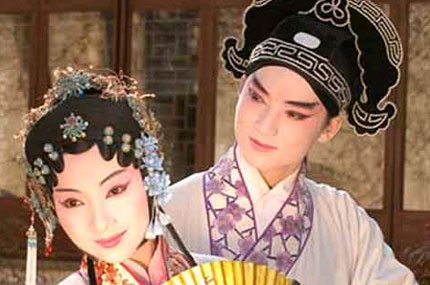
|
BIZCHINA> Photos
 |
|
Kunqu Opera
(chinadaily.com.cn)
Updated: 2008-11-04 18:56
 Kunqu Opera is one of the oldest forms of opera still existing in China, with its origins dating back to the end of the Yuan Dynasty (1271-1368). It has distinguished itself by the virtuosity of its rhythmic patterns and has exerted a dominant influence on all the more recent forms of opera in China, including the Sichuan and Beijing operas. In 2001, UNESCO (United Nations Educational, Cultural and Scientific Organization) proclaimed Kunqu Opera as a masterpiece of the Oral and Intangible Heritage of Humanity (a UNESCO program that ensures the best of every country's traditions is preserved and developed as well as made known to the outside world). Origin and History Kunqu Opera, also called Kunshanqiang, is said to be the mother of all Chinese operas. Its origins can be traced to the late Yuan Dynasty, some 600 years ago, in the lower Yangtze River Valley. Among the earliest genres of drama, the traditional performing art was named for its birthplace, Mt. Kunshan, near the city of Suzhou in today's Jiangsu Province, East China. The development of Kunqu Opera music went through several stages. In the early days, the songs were composed of long and short lines. The singer sang solo, and the orchestra came in at the end of each line. In the chorus, only percussion instruments were used. In the Ming Dynasty (1368-1644), reformed by Wei Liangfu during the reign of Emperor Jiajing, Kunqu Opera became mild, smooth, and graceful. The performers attached great importance to clear recitation, correct singing, and pure tunes. Meanwhile, the composers wrote the musical scores after working out the tunes, and the songs were written in seven-character or ten-character lines. Moreover, three types of musical instruments (stringed instruments, bamboo flutes, and drums and clappers) formed the accompaniment. In addition, Kunqu Opera had 12 roles, and the Jing and Chou roles were no longer those exclusively portraying foolish, awkward, or stingy people. Main Features Kunqu Opera is acknowledged as an elegant opera in terms of music, recitation, and the performers' movements. It is foremost acclaimed as "watermill songs" because of its soft arias and the graceful movement of its performers. Carrying forward the tradition of ancient poetry and common speech, the art is also of very high literary value. Kunqu has a complete system of acting as well as its own distinctive tunes. Its wide-ranging repertoire has many delicate and elegant tunes. The orchestra consists of traditional instruments including the dizi, a horizontal bamboo flute which plays the lead part; the xiao, a vertical bamboo flute; the sheng, a mouth organ; and the pipa, a plucked string instrument with a fretted finger board. Many Chinese local operas are greatly influenced by its tunes and acting style. The representative works of the Kunqu Opera are: The Peony Pavilion, Fifteen Strings of Coins (Shiwu Guan), Love at First Sight (Qiang Tou Ma Shang), and Escorting Jingniang Home (Qianli Song Jingniang). Risk of Disappearance Kunqu Opera, acknowledged as an elite opera, has suffered somewhat of a decline since the eighteenth century because it requires a high level of technical knowledge from the audience. Today, it is facing competition from mass culture and a lack of interest amongst the young. Of the 400 arias regularly sung in opera performances in the mid-20th century, only a few dozen are still performed.
(For more biz stories, please visit Industries)
|